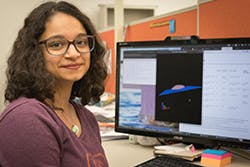Virginia Tech chemical engineering junior Preeya Achari
Understanding how water behaves at an intersection with another material and how it affects that material’s performance is helpful when trying to develop better products and devices. Virginia Tech chemical engineering junior Preeya Achari has developed and recently published as first author a new computational model to better understand the relationship between water and a type of two-dimensional material that is composed of one-atom-thick layers that are flat like a sheet of paper. The model will reportedly help predict the behavior of water at the surface of hexagonal boron nitride, a compound commonly used in cosmetic products, such as eyeshadow and lipstick.
The compound is similar to graphene, which has already shown great potential in lubrication, electronic devices, sensors, separation membranes, and as an additive for cosmetic products, according to Virginia Tech. Hexagonal boron nitride, however, has a few more favorable properties, such as its higher resistance to oxidation, flexibility, and greater strength-to-weight ratio — properties that could also be useful in the production of nanotechnology, drug delivery, and harvesting electricity from sea water.
Prior to the development of the new model, understanding the molecular-level structure of water at the contact surface with hexagonal boron nitride proved very challenging, if not impossible. The development may provide more control in performance of devices made with hexagonal boron nitride and water.
“This knowledge can help in improving the performance of boron nitride-based electronic devices,” Achari says.
Achari works in the computational lab of chemical engineering assistant professor Sanket Deshmukh. She developed the model in close collaboration with others in Deshmukh’s lab, including post-doctoral researcher Karteek Bejagam and visiting scholar Samrendra Singh. In addition to her recently published journal article, Achari was also awarded best oral presentation at the 2018 Materials Research Society meeting in Boston, Massachusetts.
For more information, visit: www.vt.edu



